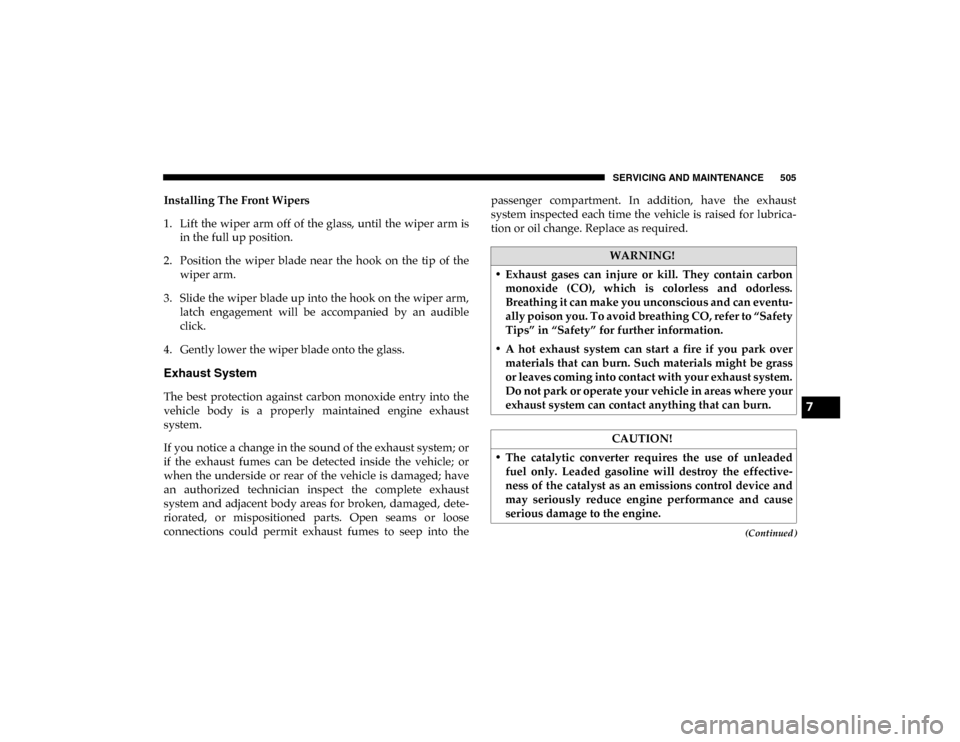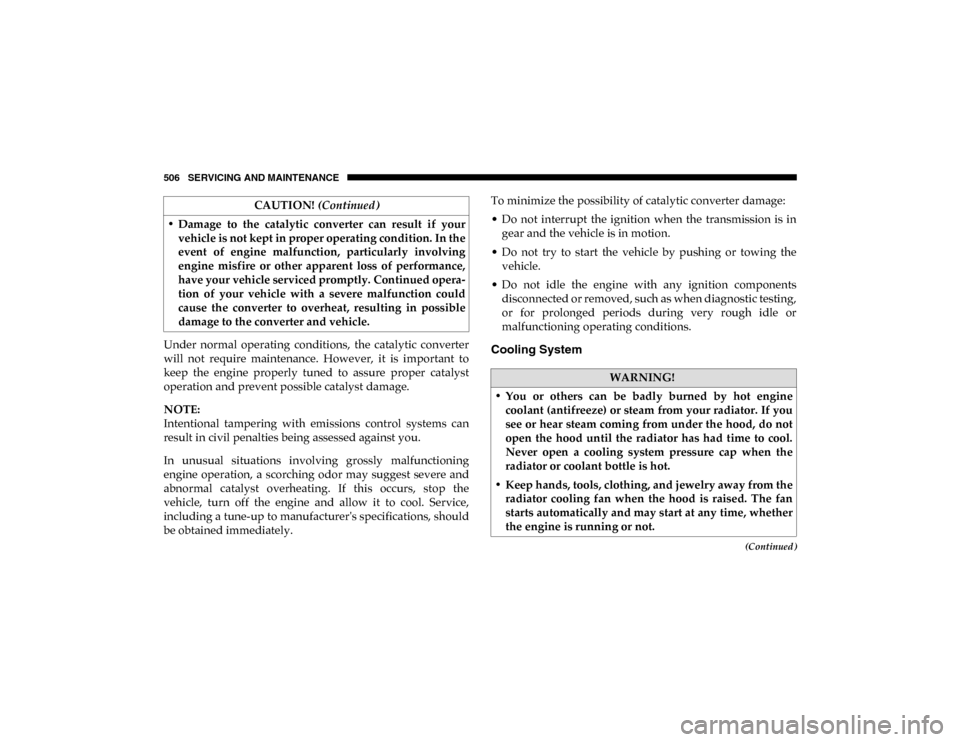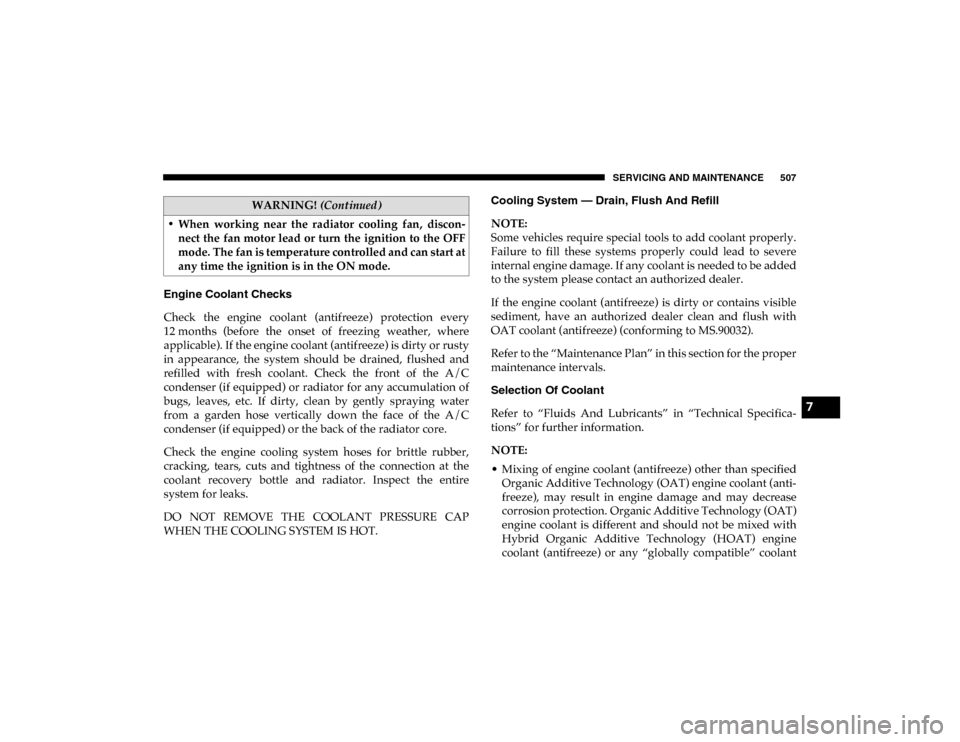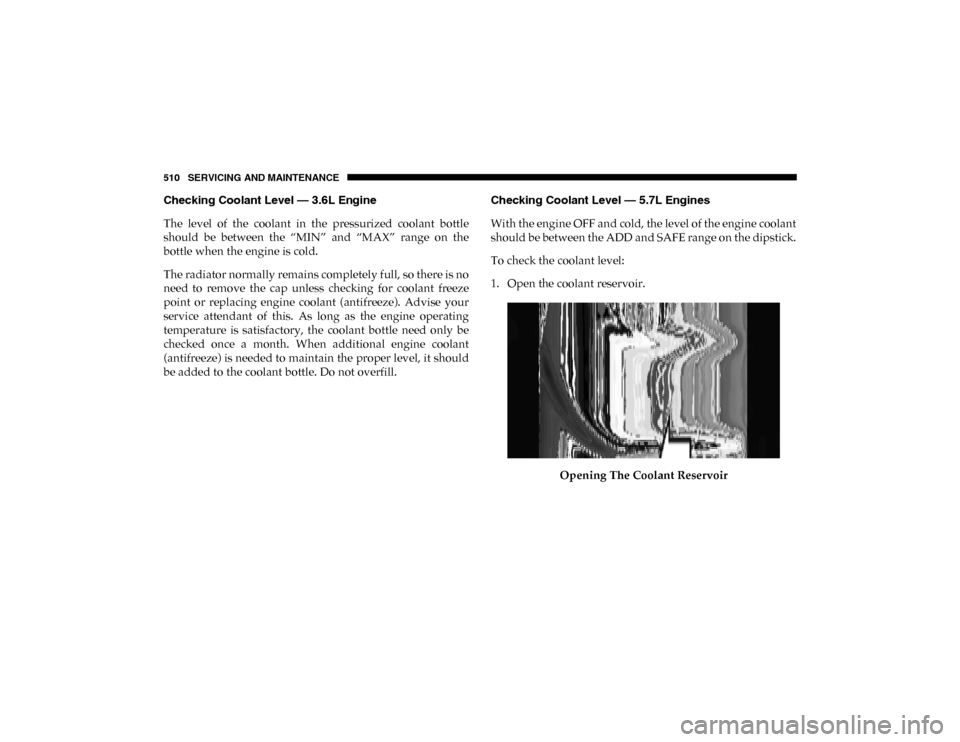engine Ram 1500 2020 Owner's Manual
[x] Cancel search | Manufacturer: RAM, Model Year: 2020, Model line: 1500, Model: Ram 1500 2020Pages: 674, PDF Size: 32.69 MB
Page 496 of 674

494 SERVICING AND MAINTENANCE
Synthetic engine oils which do not have both the engine oil
certification mark and the correct SAE viscosity grade
number should not be used.
Materials Added To Engine Oil
The manufacturer strongly recommends against the addi-
tion of any additives (other than leak detection dyes) to the
engine oil. Engine oil is an engineered product and its perfor -
mance may be impaired by supplemental additives.
Disposing Of Used Engine Oil And Oil Filters
Care should be taken in disposing of used engine oil and oil
filters from your vehicle. Used oil and oil filters, indiscrimi -
nately discarded, can present a problem to the environment.
Contact an authorized dealer, service station or govern -
mental agency for advice on how and where used oil and oil
filters can be safely discarded in your area.
Engine Oil Filter
The engine oil filter should be replaced with a new filter at
every engine oil change.
Engine Oil Filter Selection
This manufacturer's engines have a full-flow type disposable
oil filter. Use a filter of this type for replacement. The quality of replacement filters varies considerably. Only high quality
filters should be used to assure most efficient service. Mopar
engine oil filters are high quality oil filters and are recom
-
mended.
Engine Air Cleaner Filter
Refer to the “Maintenance Plan” in this section for the proper
maintenance intervals.
Engine Air Cleaner Filter Selection
The quality of replacement engine air cleaner filters varies
considerably. Only high quality filters should be used to
assure most efficient service. Mopar engine air cleaner filters
are a high quality filter and are recommended.
WARNING!
The air induction system (air cleaner, hoses, etc.) can
provide a measure of protection in the case of engine
backfire. Do not remove the air induction system (air
cleaner, hoses, etc.) unless such removal is necessary for
repair or maintenance. Make sure that no one is near the
engine compartment before starting the vehicle with the
air induction system (air cleaner, hoses, etc.) removed.
Failure to do so can result in serious personal injury.
2020_DT_1500_OM_US.book Page 494
Page 497 of 674

SERVICING AND MAINTENANCE 495
Engine Air Cleaner Filter Inspection And Replacement
Inspect engine air cleaner filter for dirt and or debris, if you
find evidence of either dirt or debris you should change your
air cleaner filter.
Engine Air Cleaner Filter Removal
1. With suitable tool fully loosen (six) fasteners on aircleaner filter.
Air Cleaner Filter 2. Lift the air cleaner cover to access the air cleaner filter.
Open Air Cleaner Filter Assembly
1 — Fasteners
2 — Air Hose Clamp
3 — Air Cleaner Cover
1 — Air Cleaner Cover
2 — Air Cleaner Filter7
2020_DT_1500_OM_US.book Page 495
Page 498 of 674

496 SERVICING AND MAINTENANCE
3. Remove the air cleaner filter element from the housingassembly.
Air Cleaner Filter Engine Air Cleaner Filter Installation
NOTE:
Inspect and clean the housing if dirt or debris is present
before replacing the air filter element.
1. Install the air cleaner filter element into the housing
assembly with the air cleaner filter inspection surface
facing downward.
2. Install the air cleaner cover onto the housing assembly.
3. Tighten the fasteners (six) on the air cleaner filter assembly
Air Conditioner Maintenance
For best possible performance, your air conditioner should
be checked and serviced by an authorized dealer at the start
of each warm season. This service should include cleaning of
the condenser fins and a performance test. Drive belt tension
should also be checked at this time.1 — Air Cleaner Cover
2 — Air Cleaner Filter
2020_DT_1500_OM_US.book Page 496
Page 505 of 674

SERVICING AND MAINTENANCE 503
Windshield Wiper Blades
Clean the rubber edges of the wiper blades and the wind-
shield periodically with a sponge or soft cloth and a mild
nonabrasive cleaner. This will remove accumulations of salt
or road film.
Operation of the wipers on dry glass for long periods may
cause deterioration of the wiper blades. Always use washer
fluid when using the wipers to remove salt or dirt from a dry
windshield.
Avoid using the wiper blades to remove frost or ice from the
windshield. Keep the blade rubber out of contact with petro -
leum products such as engine oil, gasoline, etc.
NOTE:
Life expectancy of wiper blades varies depending on
geographical area and frequency of use. Poor performance of
blades may be present with chattering, marks, water lines or
wet spots. If any of these conditions are present, clean the
wiper blades or replace as necessary. The wiper blades and wiper arms should be inspected peri
-
odically, not just when wiper performance problems are
experienced. This inspection should include the following
points:
• Wear or uneven edges
• Foreign material
• Hardening or cracking
• Deformation or fatigue
If a wiper blade or wiper arm is damaged, replace the
affected wiper arm or blade with a new unit. Do not attempt
to repair a wiper arm or blade that is damaged.
7
2020_DT_1500_OM_US.book Page 503
Page 507 of 674

SERVICING AND MAINTENANCE 505
(Continued)
Installing The Front Wipers
1. Lift the wiper arm off of the glass, until the wiper arm isin the full up position.
2. Position the wiper blade near the hook on the tip of the wiper arm.
3. Slide the wiper blade up into the hook on the wiper arm, latch engagement will be accompanied by an audible
click.
4. Gently lower the wiper blade onto the glass.
Exhaust System
The best protection against carbon monoxide entry into the
vehicle body is a properly maintained engine exhaust
system.
If you notice a change in the sound of the exhaust system; or
if the exhaust fumes can be detected inside the vehicle; or
when the underside or rear of the vehicle is damaged; have
an authorized technician inspect the complete exhaust
system and adjacent body areas for broken, damaged, dete -
riorated, or mispositioned parts. Open seams or loose
connections could permit exhaust fumes to seep into the passenger compartment. In addition, have the exhaust
system inspected each time the vehicle is raised for lubrica
-
tion or oil change. Replace as required.
WARNING!
• Exhaust gases can injure or kill. They contain carbon monoxide (CO), which is colorless and odorless.
Breathing it can make you unconscious and can eventu -
ally poison you. To avoid breathing CO, refer to “Safety
Tips” in “Safety” for further information.
• A hot exhaust system can start a fire if you park over materials that can burn. Such materials might be grass
or leaves coming into contact with your exhaust system.
Do not park or operate your vehicle in areas where your
exhaust system can contact anything that can burn.
CAUTION!
• The catalytic converter requires the use of unleaded fuel only. Leaded gasoline will destroy the effective -
ness of the catalyst as an emissions control device and
may seriously reduce engine performance and cause
serious damage to the engine.
7
2020_DT_1500_OM_US.book Page 505
Page 508 of 674

506 SERVICING AND MAINTENANCE
(Continued)
Under normal operating conditions, the catalytic converter
will not require maintenance. However, it is important to
keep the engine properly tuned to assure proper catalyst
operation and prevent possible catalyst damage.
NOTE:
Intentional tampering with emissions control systems can
result in civil penalties being assessed against you.
In unusual situations involving grossly malfunctioning
engine operation, a scorching odor may suggest severe and
abnormal catalyst overheating. If this occurs, stop the
vehicle, turn off the engine and allow it to cool. Service,
including a tune-up to manufacturer's specifications, should
be obtained immediately.To minimize the possibility of catalytic converter damage:
• Do not interrupt the ignition when the transmission is in
gear and the vehicle is in motion.
• Do not try to start the vehicle by pushing or towing the vehicle.
• Do not idle the engine with any ignition components disconnected or removed, such as when diagnostic testing,
or for prolonged periods during very rough idle or
malfunctioning operating conditions.Cooling System
• Damage to the catalytic converter can result if yourvehicle is not kept in proper operating condition. In the
event of engine malfunction, particularly involving
engine misfire or other apparent loss of performance,
have your vehicle serviced promptly. Continued opera -
tion of your vehicle with a severe malfunction could
cause the converter to overheat, resulting in possible
damage to the converter and vehicle. CAUTION!
(Continued)
WARNING!
• You or others can be badly burned by hot engine coolant (antifreeze) or steam from your radiator. If you
see or hear steam coming from under the hood, do not
open the hood until the radiator has had time to cool.
Never open a cooling system pressure cap when the
radiator or coolant bottle is hot.
• Keep hands, tools, clothing, and jewelry away from the radiator cooling fan when the hood is raised. The fan
starts automatically and may start at any time, whether
the engine is running or not.
2020_DT_1500_OM_US.book Page 506
Page 509 of 674

SERVICING AND MAINTENANCE 507
Engine Coolant Checks
Check the engine coolant (antifreeze) protection every
12 months (before the onset of freezing weather, where
applicable). If the engine coolant (antifreeze) is dirty or rusty
in appearance, the system should be drained, flushed and
refilled with fresh coolant. Check the front of the A/C
condenser (if equipped) or radiator for any accumulation of
bugs, leaves, etc. If dirty, clean by gently spraying water
from a garden hose vertically down the face of the A/C
condenser (if equipped) or the back of the radiator core.
Check the engine cooling system hoses for brittle rubber,
cracking, tears, cuts and tightness of the connection at the
coolant recovery bottle and radiator. Inspect the entire
system for leaks.
DO NOT REMOVE THE COOLANT PRESSURE CAP
WHEN THE COOLING SYSTEM IS HOT. Cooling System — Drain, Flush And Refill
NOTE:
Some vehicles require special tools to add coolant properly.
Failure to fill these systems properly could lead to severe
internal engine damage. If any coolant is needed to be added
to the system please contact an authorized dealer.
If the engine coolant (antifreeze) is dirty or contains visible
sediment, have an authorized dealer clean and flush with
OAT coolant (antifreeze) (conforming to MS.90032).
Refer to the “Maintenance Plan” in this section for the proper
maintenance intervals.
Selection Of Coolant
Refer to “Fluids And Lubricants” in “Technical Specifica
-
tions” for further information.
NOTE:
• Mixing of engine coolant (antifreeze) other than specified Organic Additive Technology (OAT) engine coolant (anti -
freeze), may result in engine damage and may decrease
corrosion protection. Organic Additive Technology (OAT)
engine coolant is different and should not be mixed with
Hybrid Organic Additive Technology (HOAT) engine
coolant (antifreeze) or any “globally compatible” coolant
• When working near the radiator cooling fan, discon
-
nect the fan motor lead or turn the ignition to the OFF
mode. The fan is temperature controlled and can start at
any time the ignition is in the ON mode.
WARNING! (Continued)
7
2020_DT_1500_OM_US.book Page 507
Page 510 of 674

508 SERVICING AND MAINTENANCE
(antifreeze). If a non-OAT engine coolant (antifreeze) is
introduced into the cooling system in an emergency, the
cooling system will need to be drained, flushed, and
refilled with fresh OAT coolant (conforming to MS.90032),
by an authorized dealer as soon as possible.
• Do not use water alone or alcohol-based engine coolant (antifreeze) products. Do not use additional rust inhibitors
or antirust products, as they may not be compatible with
the radiator engine coolant and may plug the radiator.
• This vehicle has not been designed for use with propylene glycol-based engine coolant (antifreeze). Use of propylene
glycol-based engine coolant (antifreeze) is not recom -
mended.
• Some vehicles require special tools to add coolant prop -
erly. Failure to fill these systems properly could lead to
severe internal engine damage. If any coolant is needed to
be added to the system please contact an authorized
dealer.
Adding Coolant
Your vehicle has been built with an improved engine coolant
(OAT coolant conforming to MS.90032) that allows extended
maintenance intervals. This engine coolant (antifreeze) can
be used up to 10 years or 150,000 miles (240,000 km) before
replacement. To prevent reducing this extended mainte -nance period, it is important that you use the same engine
coolant (OAT coolant conforming to MS.90032) throughout
the life of your vehicle.
Please review these recommendations for using Organic
Additive Technology (OAT) engine coolant (antifreeze) that
meets the requirements of FCA Material Standard MS.90032.
When adding engine coolant (antifreeze):
• We recommend using Mopar® Antifreeze/Coolant 10 Year/
150,000 Mile (240,000 km) Formula OAT (Organic Additive
Technology) that meets the requirements of FCA Material
Standard MS.90032.
• Mix a minimum solution of 50% OAT engine coolant that meets the requirements of FCA Material Standard
MS.90032 and distilled water. Use higher concentrations
(not to exceed 70%) if temperatures below −34°F (−37°C)
are anticipated. Please contact an authorized dealer for
assistance.
• Use only high purity water such as distilled or deionized water when mixing the water/engine coolant (antifreeze)
solution. The use of lower quality water will reduce the
amount of corrosion protection in the engine cooling
system.
2020_DT_1500_OM_US.book Page 508
Page 511 of 674

SERVICING AND MAINTENANCE 509
NOTE:
• It is the owner's responsibility to maintain the proper levelof protection against freezing according to the tempera -
tures occurring in the area where the vehicle is operated.
• Some vehicles require special tools to add coolant prop -
erly. Failure to fill these systems properly could lead to
severe internal engine damage. If any coolant is needed to
be added to the system, please contact a local authorized
dealer.
• Mixing engine coolant (antifreeze) types is not recom -
mended and can result in cooling system damage. If
HOAT and OAT coolant are mixed in an emergency, have
a authorized dealer drain, flush, and refill with OAT
coolant (conforming to MS.90032) as soon as possible.
Cooling System Pressure Cap
The cap must be fully tightened to prevent loss of engine
coolant (antifreeze), and to ensure that engine coolant (anti -
freeze) will return to the radiator from the coolant expansion
bottle/recovery tank if so equipped.
The cap should be inspected and cleaned if there is any accu-
mulation of foreign material on the sealing surfaces. Disposal Of Used Coolant
Used ethylene glycol-based coolant (antifreeze) is a regu-
lated substance requiring proper disposal. Check with your
local authorities to determine the disposal rules for your
community. To prevent ingestion by animals or children, do
not store ethylene glycol-based coolant in open containers or
allow it to remain in puddles on the ground. If ingested by a
child or pet, seek emergency assistance immediately. Clean
up any ground spills immediately.WARNING!
• Do not open hot engine cooling system. Never add engine coolant (antifreeze) when the engine is over -
heated. Do not loosen or remove the cap to cool an over -
heated engine. Heat causes pressure to build up in the
cooling system. To prevent scalding or injury, do not
remove the pressure cap while the system is hot or
under pressure.
• Do not use a pressure cap other than the one specified for your vehicle. Personal injury or engine damage may
result.
7
2020_DT_1500_OM_US.book Page 509
Page 512 of 674

510 SERVICING AND MAINTENANCE
Checking Coolant Level — 3.6L Engine
The level of the coolant in the pressurized coolant bottle
should be between the “MIN” and “MAX” range on the
bottle when the engine is cold.
The radiator normally remains completely full, so there is no
need to remove the cap unless checking for coolant freeze
point or replacing engine coolant (antifreeze). Advise your
service attendant of this. As long as the engine operating
temperature is satisfactory, the coolant bottle need only be
checked once a month. When additional engine coolant
(antifreeze) is needed to maintain the proper level, it should
be added to the coolant bottle. Do not overfill.Checking Coolant Level — 5.7L Engines
With the engine OFF and cold, the level of the engine coolant
should be between the ADD and SAFE range on the dipstick.
To check the coolant level:
1. Open the coolant reservoir.
Opening The Coolant Reservoir
2020_DT_1500_OM_US.book Page 510